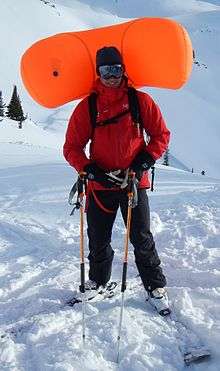Backcountry skiing
Backcountry skiing (US), also called off-piste (Europe) or out-of-area, is skiing in the backcountry on unmarked or unpatrolled areas either inside or outside a ski resort's boundaries.[1] This contrasts with alpine skiing which is typically done on groomed trails benefiting from a ski patrol. Unlike ski touring, backcountry skiing can include the use of ski lifts including snowcats and helicopters. Recent improvements in equipment have increased the popularity of the sport.[2]
Terminology
The terms "backcountry" and "off-piste" refer to where the skiing is being done, while terms like ski touring, ski mountaineering, telemark, freeriding, and extreme skiing describe what type of skiing is being done. Terms for backcountry skiing exist according to how the terrain is accessed, and how close it is to services. Backcountry can include the following:[3]
- Frontcountry: off-trail within ski area boundaries where ski lifts and emergency services are close at hand.
- Slackcountry: terrain outside of the ski area boundary that is accessed from a lift without having to use skins or bootpack. Usually this also includes area with access back to the lift as well. For purists, this could also include where people use a car as a shuttle.
- Sidecountry: terrain outside marked ski area boundaries yet accessible via ski lift. Typically sidecountry requires the skier to hike, skin, or climb within ski area boundaries to reach or return from the sidecountry area, or both.
- Backcountry: skiing in remote areas not within ski area boundaries.
Safety

Backcountry and off-piste skiing can be hazardous due to avalanche, exhaustion, weather, cliffs, rock fall, and tree wells. Avalanches result in about one fatality per month in the United States.[4] Backcountry skiers following best practices carry avalanche transceivers, shovels and probes to perform avalanche rescues. In recent years training courses on how to use these tools and how to assess the risk of avalanches have become commonplace in North America[5].
In Europe and Canada off-piste skiing is generally permitted at ski resorts. In the United States off-piste skiing may or may not be; regulations vary by ski area. Many ski resorts prohibit it outright and some simply post warning signs that skiers are leaving the patrolled ski area boundaries.
See also
References
- ↑ Volken, Martin; Schell, Scott; Wheeler, Margaret (2007-11-27). Backcountry Skiing: Skills for Ski Touring and Ski Mountaineering. Mountaineers Books. ISBN 978-1-59485-038-7.
- ↑ "Popularity of backcountry skiing worries some in industry". CBC. Retrieved 13 July 2014.
- ↑ "Definition of Backcountry, Frontcountry, Sidecountry and Slackcountry Skiing".
- ↑ "U.S. Avalanche Accidents Reports". Retrieved 13 July 2014.
- ↑ "Growing 'respect' for avalanches leads to declining death rates". CBC News. Retrieved 2017-08-27.